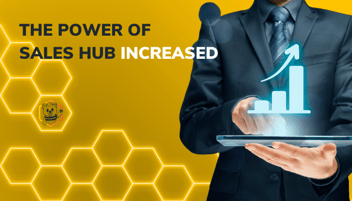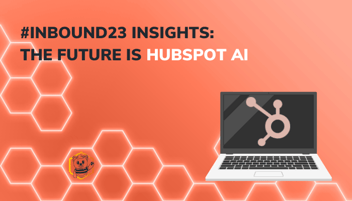
Google Analytics: Stay Ahead of the GA4 Curve AS UA Fades Away
Prepare yourself for a data blackout this year if you haven't made the shift from the old Google Analytics to Google Analytics 4 (GA4). As of July 1, 2023, UA has halted data processing, leaving us with the challenge of mastering the next generation of Google Analytics.
GA4 is an entirely new frontier, transforming data collection and offering a comprehensive measurement approach. It's like hitting the reset button, presenting us with a fresh learning curve to conquer.
While the switch may initially seem daunting, there's a silver lining: the ease of automatic event tracking, which ensures a more comprehensive capture of user behavior. Moreover, the migration of features from GA360 to GA4 is set to delight analysts.
In this article, we'll delve into everything you need to know about Google Analytics 4:
-
Understanding GA4
-
What to expect from GA4
-
Implications for marketers.
-
How to connect GA4 to HubSpot.
Understanding GA4
Google Analytics is a familiar tool used to monitor and assess website traffic and overall performance. By embedding a script into your website, visitor interactions are tracked and reported in the Google Analytics dashboard. However, GA4 brings forth a multitude of advancements, including AI-powered reporting. The most significant divergence between Universal Analytics and GA4 lies in the realm of event tracking.
In Universal Analytics (GA3), events primarily revolve around clicks. On the other hand, GA4 introduces a broader definition of events, encompassing page views, social interactions, and various other user behaviors. Furthermore, GA4 allows you to set up multiple parameters for each event, providing more detailed information such as the event's geographical origin.
The concept of 'sessions' also undergoes transformation between GA3 and GA4. In GA3, a session is defined as a series of user activities within a specific time window. However, GA4 interprets sessions as a collection of events performed by a user. These events can range from completing a purchase to clicking a button, encompassing a wider array of actions.
What to Expect From GA4
To truly grasp the impact of GA4, let's examine these five key features:
-
Refined Data Collection
-
AI-Driven Forecasts and Insights
-
Holistic Understanding of the Customer Journey
-
Enhanced User Data Management
-
Mitigating Spam Interference
Refined Data Collection:
Google Analytics 4 introduces a revamped approach to data gathering. Unlike Universal Analytics, which follows a session-based data model and accumulates data as hits within these sessions (including page hits and event hits), GA4 adopts a user-centric model, collecting data as events.
Each event is identified by a unique name and supplemented with additional parameters that provide contextual information. These events can encompass page views, transactions, social interactions, and more. This enables you to acquire highly granular metrics while adhering to privacy norms.
AI-Driven Forecasts and Insights:
GA4 has the potential to significantly enhance the strategic planning of marketing campaigns. Its AI-generated insights can detect emerging trends, such as increased demand for a specific product. The embedded machine learning technology can also forecast outcomes like churn rates and probable conversions and sales. Armed with these insights, marketers can strategically promote relevant products and target pertinent audiences.
Holistic Understanding of the Customer Journey:
A standout feature of Google Analytics 4 is its emphasis on the customer lifecycle for reporting purposes. Reports are structured around the trajectory of the customer's journey.
For example, you can identify the channels that drive customers to your website (Acquisition), understand the activities they engage in (Engagement), and determine if they remain on your webpage after conversion (Retention). This approach provides a comprehensive view of user interactions with your website across various devices and channels.
Enhanced User Data Management:
In the evolving digital landscape, Google is shifting away from third-party cookies, necessitating a focus on first-party data in analytics tools. GA4 addresses this change by offering nuanced data controls to help advertisers comply with strict data regulations.
For instance, GA4 introduces a consent mode, assisting website owners in obtaining user consent for analytics and advertisements. It simplifies the process of responding to user data removal requests, underscoring a commitment to respecting user privacy.
Mitigating Spam Interference:
Many Google Analytics users have experienced the annoyance of spam referrals. Previously, spammers flooded Google Analytics accounts with fabricated data using the Measurement Protocol. This led to sudden traffic surges or a deluge of visits from questionable sources, disrupting accurate data collection.
With GA4, only hits associated with a confidential key can transmit data to a GA4 property. This key is retrievable from your GA4 data stream settings and is not publicly accessible, providing an extra layer of protection against spam interference.
Implications for Marketers:
You might be wondering, what does all of this mean?
It means that by leveraging the information obtained from GA4 effectively, you can attract more relevant audiences for your marketing campaigns.
The enhanced measurement capabilities of GA4 can help businesses connect with the right target audience for their ad campaigns. By pulling data from various platforms, you gain a comprehensive 360-degree view of the customer journey, leading to more favorable results and a higher return on investment.
Additionally, GA4 offers predictive metrics that can provide insights into potential sales from specific customer groups. Armed with this knowledge, you can fine-tune your marketing strategies and anticipate better outcomes.
To connect Google Analytics to HubSpot, follow these steps:
-
In your HubSpot account, navigate to settings.
-
Click "Integrations" and then select "Google Analytics."
-
Click "Connect" and you will be prompted to sign in to your Google account.
-
Select the Google Analytics account that you want to connect to HubSpot.
-
Choose the specific property and view that you want to connect to HubSpot.
-
Click "Connect" to complete the integration.
Make the transition to GA4 today and seize the advantages it offers to stay ahead of the curve in the dynamic world of analytics.





